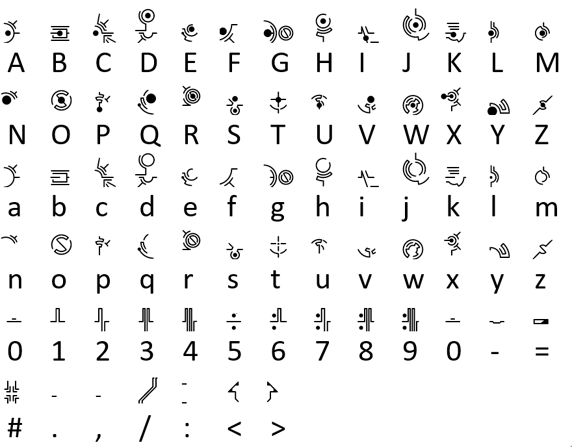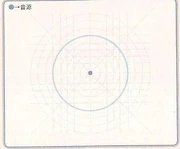The Hymmnos Language (ヒュムノス語, hyumunosu go?), called Hymnos in the English-localized materials of the series, is a language created by Akira Tsuchiya for the Ar tonelico series. Hymmnos saw relatively widespread use in ancient times in the world of Ar Ciel, but it has fallen out of common use by the time of Ar tonelico: Melody of Elemia. The language is now primarily used by Reyvateils to communicate with their servers, though it has other uses as well; humans can use it to control ancient machinery. Hymmnos's vocabulary stems from a variety of sources, including English, Latin, Japanese, Sanskrit and German.
Hymmnos is notable for placing a heavy emphasis on the emotions of the speaker. A statement in Hymmnos can explicitly convey how the speaker feels about what they are speaking about.
Origins[]
Hymmnos is derived from a language used by the Moon Chanters, an ancient line of shamans who invoked magic through spell casting. Only two dialects from that language have survived into modern times: Kurt Ciel and Carmena Foreluna. While Carmena Foreluna sees practically no use, Kurt Ciel is still spoken in a limited fashion.
Some time after the construction of the First Tower of Ar tonelico, the people in charge of the project adapted the Moon Chanters' language for use as an interface between the people and the Tower. More details about the story of individual dialects can be found in the dialects section of this article.
Writing Systems[]
Hymmnos is generally represented through the eponymous Hymmnos Script.
Hymmnos Script[]
The glyphs that make up the Hymmnos Script can be seen below.
Historically, the Hymmnos Script was standardized by the El Elemia Tower Administration Bureau in 3018 AD. The glyphs in this writing system are based on a shape called the Emission Concentric Circle. The Emission Concentric Circle is actually made up of several circles, which all share a common center point. This center point is known as the Sound Source.
The glyphs themselves contain feelings, which are represented by the waveforms that make up the glyphs. Arching shapes represent "peace (α-Waves)", radiating shapes represent "stimuli (γ-Waves)" and the vertical and parallel lines represent "tension (β-Waves)". The Sound Source can be seen as the source of these feelings.
Numbers are represented as square wave patterns.
Dialects[]
Because of its great age and its widespread usage around the world of Ar Ciel, several unique dialects of Hymmnos have developed. These dialects behave similarly to dialects of real world languages, having much of the same vocabulary and grammar but adding, removing or changing certain aspects.
The dialects are referred to as "Notes." The following Notes of Hymmnos are known to have been created by the time of the Third Era:
- Central Standard Note (Standard dialect)
- Kurt Ciel Note (Ancient language from before the First Era)
- Cluster Note (Sol Cluster dialect)
- Alpha Note (Origin Spell)
- Ancient Metafalss Note (Sacred language from the First Era)
- New Testament of Pastalie (Pastalia dialect)
Central Standard Note[]
The Central Standard Note (中央正純律, chuouseijunritsu?) is the "standard" dialect of Hymmnos. It was first created and standardized by El Elemia and the managers of the Ar tonelico project to allow humans to interface with the Tower. It is the most widely used Note of Hymmnos, used by Reyvateils for Songs and by humans for operation of the Tower.
Over time, Central Standard Hymmnos has evolved and absorbed new features as other Notes created them. Song Server operations are almost exclusively written using Central Standard Note.
Kurt Ciel Note[]
Although referred to as a Note, the Kurt Ciel Note (クルトシエール律, kurutoshieeruritsu?) is actually the basis for the Central Standard Note of Hymmnos. Kurt Ciel was the language used by the Moon Chanters to cast spells. In modern times, it has largely fallen out of use.
Cluster Note[]
The Cluster Note (クラスタ律, kurasutaritsu?) was created during the First Era by people in the Sol Cluster region. It was intended to rival Central Standard Note in power and functionality, likely with the intention of surpassing it. Cluster Note never caught on, however, and excepting for a few limited uses in some Metafalssian Songs, this Note has never seen use outside the region of Sol Cluster. Therefore, this Note is exclusive to the Harvestasha Song Server.
Alpha Note[]
The 3 Reyvateil Origins can create Hymmnos words and structures at will. Such creations are referred to as Alpha Note (アルファ律, arufaritsu?). While the Alpha Note can be immensely powerful, its use is limited to the Tower that the Origin manages. This is because the dialect is only stored within that Tower, rather than being a part of Standard Hymmnos; a Clustanian Reyvateil connected to the HARVESTASHA Song Server cannot use Alpha Note Hymmnos stored on the ARTONELICO Song Server, and a Sol Ciel Reyvateil connected to ARTONELICO cannot use Alpha Note Hymmnos located on HARVESTASHA.
Ancient Metafalss Note[]
The Ancient Metafalss Note (古メタファルス律, inishie metafarusuritsu?) was created during the early 2000s by the people of Metafalss. While this Note incorporates heavily the spiritual teachings Metafalss is known for, it was developed using a mathematical approach to produce words whose pronunciation emitted the greatest power, making every single word in the Ancient Metafalss Note much more powerful than any of the words of the Central Standard Note. However, this was done at the cost of making this Note difficult to pronounce and utilize.
Although Metafalss began to decline in the 3000s, diplomatic relations between Metafalss and El Elemia lead to Ancient Metafalss Note being registered onto Ar tonelico's Song Server. This means that Reyvateils connected to ARTONELICO are capable of using Ancient Metafalss Note in their Songs.
New Testament of Pastalie[]
The New Testament of Pastalie (新約パスタリエ, shin'yaku pasutarie?) was created for use with Infel Phira during its construction around year 3300 AD. Only Reyvateils connected to Infel Phira, referred to as Infel Phira Dependents (IPDs), can utilize the New Testament natively. Due to the low energy output of Infel Phira compared to that of Ar tonelico, the New Testament was heavily optimized for speed rather than power. This optimization makes Songs written in Pastalie faster than those written in Central Standard Note, but it also makes any Songs using Pastalie incompatible with the Song Servers that don't support them. On the other hand, IPDs can sing using any Note due to Infel Phira providing emulation capabilities that translate on the fly all words from other Notes into Pastalie, although this impacts negatively on the Song's performance.
The grammar of the New Testament of Pastalie differs heavily from the other Notes that were created during the First Era, so another guide has been made specifically for it. It can be found at the New Testament of Pastalie article linked below.
Grammar for Standard Hymmnos[]
For details on how the grammar for Standard Hymmnos is structured and which rules govern the forming of its sentences, please check the Standard Hymmnos article.
Grammar for New Testament of Pastalie Hymmnos[]
For details on how the grammar for the New Testament of Pastalie Hymmnos is structured and which rules govern the forming of its sentences, please check the New Testament of Pastalie article.
Lexicon[]
All of the currently known words for all of the Hymmnos dialects can be found over at Hymmnos:Lexicon.


